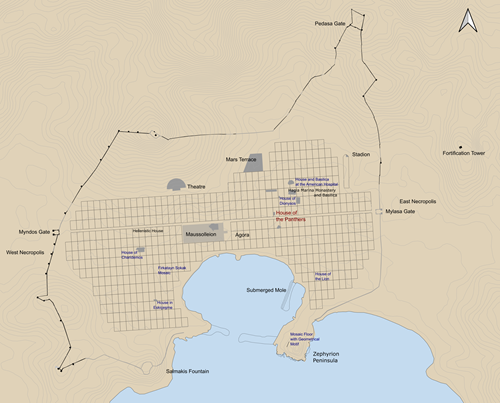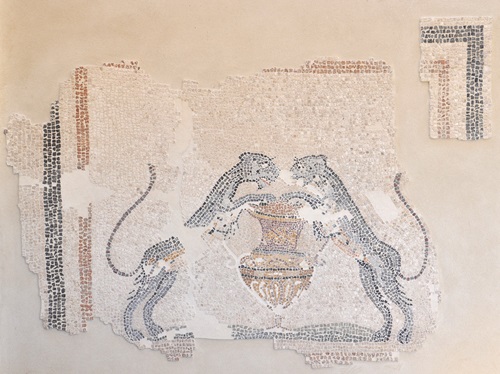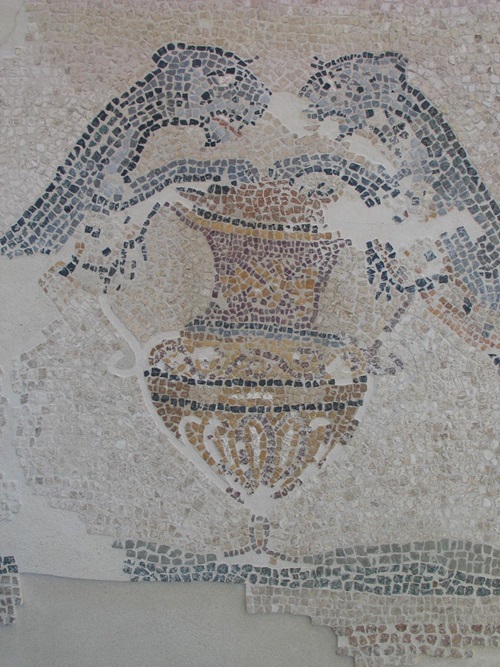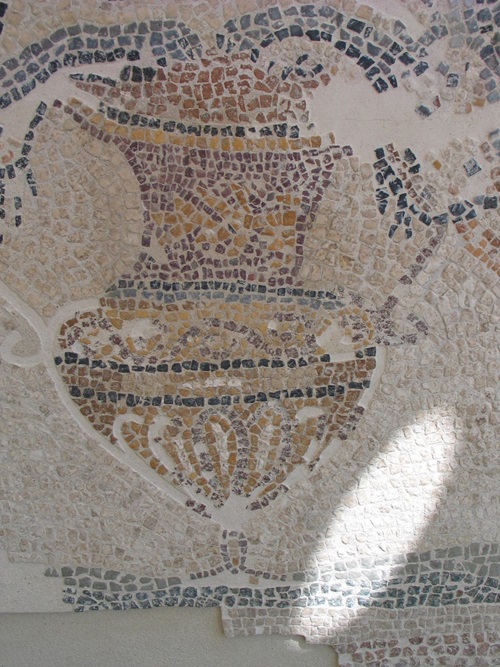By B. Poulsen
During the construction of a house in the centre of modern Bodrum in 1990, on the east side of Davut Sokak (approximately houses nos. 3-5), a couple of rooms of an ancient building were revealed. The ancient remains were situated immediately to the north of the Turgut Reis street that corresponds approximately to the wide avenue that in antiquity cut through the city from the Mylasa Gate to the Myndos Gate.
 Fig. 1. Plan of Halikarnassos with the House of the Panthers indicated (N. Bargfeldt and F.S. Nielsen).
Fig. 1. Plan of Halikarnassos with the House of the Panthers indicated (N. Bargfeldt and F.S. Nielsen).The mosaic
 Fig. 2. Mosaic with heraldically opposed panthers (B. Poulsen).
Fig. 2. Mosaic with heraldically opposed panthers (B. Poulsen).

Fig. 3. Detail of the panel (B. Poulsen).
The panel represents two confronted panthers standing on either side of a krater. The panthers are resting on their hind legs and placing their forelegs on the rim of the tall vessel. The tails are raised and form S-curves behind their backs. The ground-line is indicated by curving lines of tesserae of light bluish-grey and dark green.The two slim panthers are almost exact mirror images of each other. They are made with tesserae of various shades of blue and light blue, the darker blue being used for outlining the back and main lines of the body, head, and fur on the legs. The tails appear purple alternating with dark green. The fur of their bellies is indicated by yellow and a few pink tesserae. Their mouths are open showing white teeth and a red tongue. Their eyes are indicated by white tesserae.

Fig. 4. Detail of krater (B. Poulsen).
The vessel placed between the panthers looks like an amphora but is more probably a krater with a wide rim on an outward-curving neck on a bulbous ovoid body and a small conical base. The S-shaped handles are made with a single line of purple tesserae, while the wine inside the krater is indicated by red tesserae. The krater is mainly yellow, but the neck appears purple with yellow tesserae forming a (laurel?) wreath encircling the neck. On the shoulder runs a wave border, and the lower part of the body has gadroons of purple tongues.Motif and date
The motif of two felines flanking a wine vessel was immensely popular over many centuries and not only in mosaics. A similar depiction has recently been found in a building with floor mosaics in Eskiçesme, and another is preserved in a mosaic floor in a building at Kamp Yeri (near Ḉiftlik Köyü) situated only a few kilometres southeast of ancient Halikarnassos. The theme is related to Dionysos, and the preserved parallels in mosaics show that this motif sometimes forms part of a Dionysiac setting. The krater with a wide rim, an outward-curving neck, a bulbous ovoid ribbed body, a small conical base, and S-shaped handles is extremely popular during Late Antiquity both on Kos and in Karia. The style of the execution may indicate a date in the 4th or 5th century AD. The motif would have been appropriate for a triclinium.
Publications and Preliminary Reports
Collins, B. & A. Zäh 2006: Byzantinische Thermen in Karien: Eine früh byzantinische Thermenanlage im unteren Gerekuyu Dere, bei Bodrum, Quaderni Friulani di Archeologia
Poulsen, B. 2011: Halikarnassos during the Imperial period and Late Antiquity, in L. Karlsson & S. Carlsson (eds.), Labraunda and Karia, Uppsala, 424-443.
Poulsen, B., E. Benli Bağcı, S. Deniz Kesici & G. Uzala: Some recently found mosaic floors in Bodrum (ancient Halikarnassos), in Mosaic in Context, XVth Conference of the Association Internationale pour l’Étude de la Mosaïque Antique (17-21 october 2022 Lyon - Saint-Romain-en-Gal), Lyon 2024 (forthcoming).
Scheibelreiter-Gail, V. 2011: Die Mosaiken Westkleinasiens. Tessellate des 2. Jahrhunderts v. Chr. bis Anfang des 7. Jahrhunderts n. Chr. SoSchrÖAI 48,
Zäh, A., F. Giordano & V. Ruggieri 1997: La penisola di Alicarnasso in età bizantina 1, OrChrPer 63, 1997, 119-161.